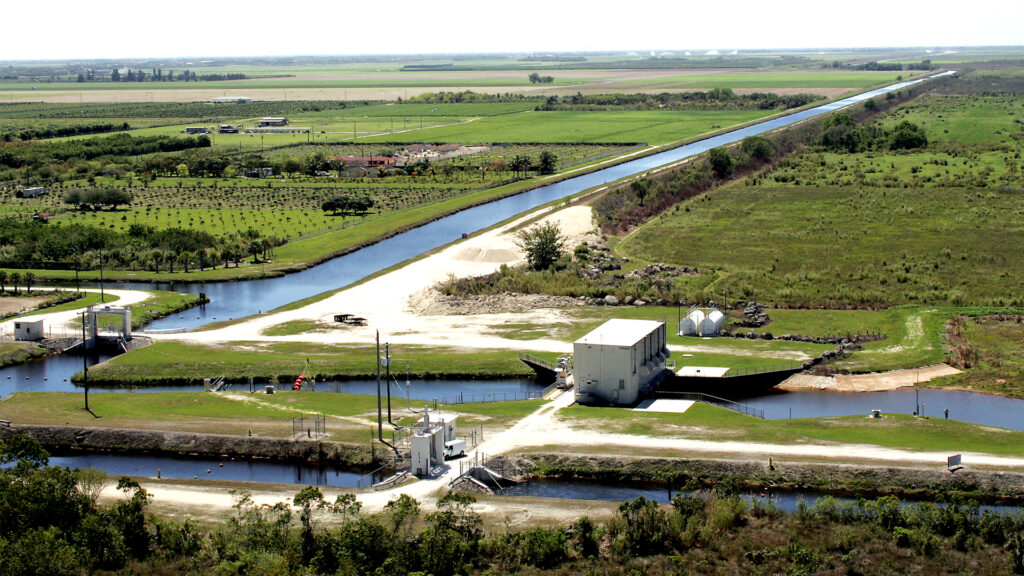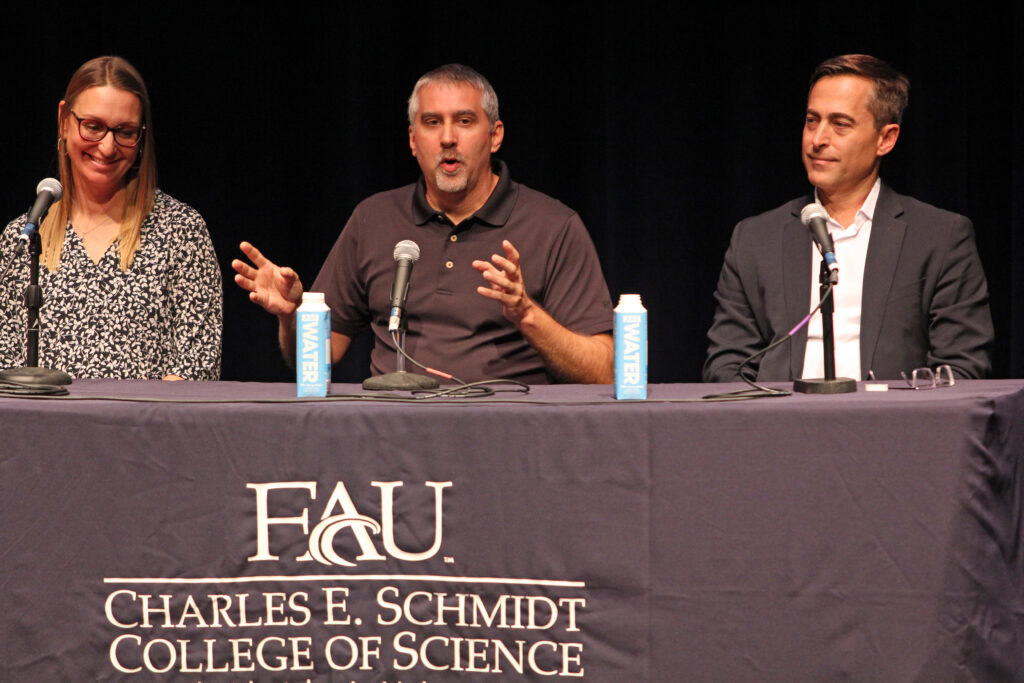By Laurie Mermet, The Invading Sea
The Florida Everglades once stretched across a third of Florida, a vast watershed spanning from the Kissimmee River near Orlando to the Florida Keys. Now, half of it is gone.

The Everglades has been dramatically altered by decades of human actions, losing 70% of its water flow to engineering projects done to prevent flooding and accommodate agricultural and urban expansion.
With a massive restoration effort ongoing, fixing the mistakes of the past is complicated by the realities of Florida’s present and future: the impacts of climate change and the state’s continuing population growth. These issues were explored in a panel discussion Nov. 19 at Florida Atlantic University.
The discussion was moderated by Jenny Staletovich, an environmental reporter for South Florida public radio station WLRN who hosts the Bright Lit Place podcast on Everglades restoration. The panel featured six experts on Everglades issues, ranging from lake ecology to geology and restoration science.
“We’re not trying to make the Everglades exactly like it was 100 years ago,” said panelist Nick Aumen, regional science advisor for the U.S. Geological Survey. “We can’t. Half of it is gone. What we’re doing now is managing for change.”
Changes in the ecosystem
Massive engineering projects dramatically altered the Everglades over the course of the 20th century.
The meandering Kissimmee River was straightened to control flooding, canals were built to divert water from Lake Okeechobee and a dike was built around the lake, and the Everglades Agricultural Area was created for sugarcane farming and other agriculture. By 1963, half of the Everglades had been channelized and drained.

In 2000, Congress passed the Comprehensive Everglades Restoration Plan (CERP). Colin Polsky, founding director of FAU’s School of Environmental, Coastal, and Ocean Sustainability, described the plan as “probably the single-largest restoration effort in the history of the world” and “one of the singularly most bipartisan efforts in the environmental domain.”
The project’s aims include restoring the natural water flow through the Everglades.
“The basis of our restoration plan is to get the water right because it is a water-driven system,” Auman said.
Restoring the flow helps improve water quality and benefits habitat and wildlife. But Scott Markwith, biogeographer and FAU professor, emphasized the nuanced nature of ecosystem restoration
“It’s not a straight line,” Markwith said. “It’s not a win always for every organism. These systems are incredibly complex.”
He used the example of predator-prey relationships, noting that while some species might benefit from restoration, their prey could simultaneously be negatively impacted.
The restoration project has been plagued by delays and increasing costs. Most recently, nearly $1.1 billion was provided to the U.S. Army Corps of Engineers’ South Florida Ecosystem Restoration Program to support ongoing projects.
Staletovich highlighted the bureaucratic hurdles.
“The authorization process for Everglades projects is not easy. It is a congressional process where projects can get authorized. If the costs exceed $25 million, they have to go back to Congress to be reauthorized again,” she said.
Florida’s population growth adds another layer of complexity for conservation efforts such as prescribed burning.

“I think the number right now, the net increase in Florida population is somewhere around 1,500 people a day … a lot of them are coming to the southeast coast here and also more recently, to the southwest coast,” Aumen said.
Development also makes it harder to conduct prescribed burns, which reduce wildfire risk while improving the health of forests.
“The more development we have on the landscape, the more we lose the ability to do prescribed burning, because people don’t want fire in their backyard,” Polsky explained.
Accounting for the impacts of climate change considerations has been particularly challenging, according to the panelists.
“As the years have gone forward and we recognize how changing the climate is, we recognize how inevitable change is in the parks,” said Erik Stabenau, branch chief of restoration science at the National Park Service’s South Florida Natural Resources Center.
He emphasized the importance of resilience in restoration efforts.
“On the Everglades restoration program, we’ve been working very, very hard at getting enough clean, fresh water into the Everglades to really create a strong, resilient system that can take some of the hits that our actions and climate actions and just seasonal events can take,” Stabenau said.
Aumen stressed the uncertainty surrounding sea-level rise and storm intensification, emphasizing the difficulty in predicting these factors.
He noted that engineers, tasked with designing a billion-dollar restoration project, will need precise data – such as estimates of increased rainfall, the frequency of storms and their projected intensity – to guide their plans.
All of these factors make the massive restoration effort even more complex. As Auman put it, “Everglades restoration is not rocket science – it’s much harder.”
Laurie Mermet is a Florida Atlantic University senior majoring in multimedia journalism who is reporting for The Invading Sea during the fall 2024 semester. Banner photo: The Bright Lit Place panel discussion at FAU (Photo courtesy of Zach Greathouse/FAU).
The Invading Sea is managed by FAU’s Center for Environmental Studies. Sign up for The Invading Sea newsletter by visiting here. To support The Invading Sea, click here to make a donation. If you are interested in submitting an opinion piece to The Invading Sea, email Editor Nathan Crabbe at nc*****@*au.edu.



